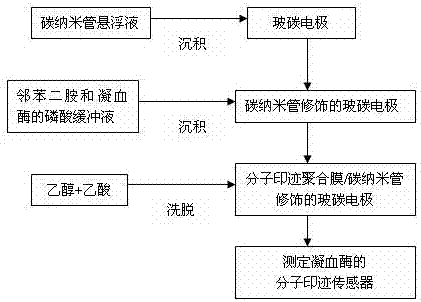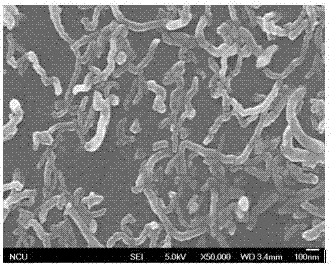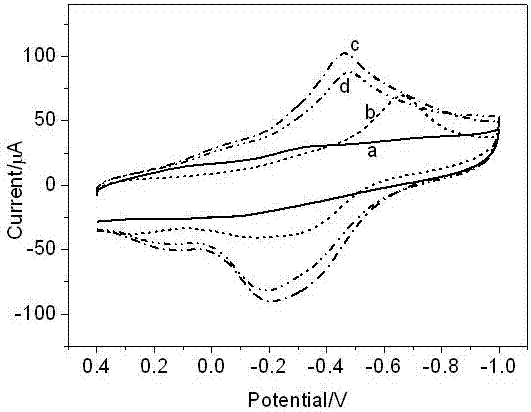A method for detecting thrombin with a molecularly imprinted electrochemical sensor
A technology of molecular imprinting and detection methods, which is applied in the fields of chemical sensing and electroanalytical chemical detection, can solve the problems of polluted electrodes, inconvenient addition of electrochemical probes, cumbersome and time-consuming enzyme labeling catalytic methods, etc., and achieve simple and sensitive detection Effect
- Summary
- Abstract
- Description
- Claims
- Application Information
AI Technical Summary
Problems solved by technology
Method used
Image
Examples
Embodiment 1
[0025] Molecularly imprinted sensors based on electropolymerization of o-phenylenediamine based on carbon nanotube materials, such as figure 1 shown.
[0026] (1) Prepare a 0.5 mg / mL carboxylated carbon nanotube suspension, place a clean glassy carbon electrode in the carbon nanotube suspension, and conduct electrodeposition at a constant potential of 1.0 V for 30 s to obtain a carbon nanotube-modified Glassy carbon electrode.
[0027] (2) Place the carbon nanotube modified electrode in pH 5.0 phosphate buffer solution containing 0.3 mg / mL o-phenylenediamine and 0.01 mg / mL thrombin, deposit at 0.7 V for 5 min, and then the modified After the electrode was rinsed with deionized water, the molecularly imprinted polymer membrane-thrombin / carbon nanotube modified glassy carbon electrode was prepared
[0028] (3) Elute the molecularly imprinted polymeric membrane-thrombin / carbon nanotube modified glassy carbon electrode in a mixed solution of ethanol:acetic acid [V:V=1:0.2] to re...
Embodiment 2
[0030] Preparation of molecularly imprinted sensors based on electropolymerization of o-phenylenediamine based on carbon nanotube materials.
[0031] (1) Prepare a 1.5 mg / mL suspension of carboxylated carbon nanotubes, place a clean glassy carbon electrode in the suspension of carbon nanotubes, and conduct electrodeposition at a constant potential of 1.5 V for 400 s to prepare carbon nanotube-modified glass carbon electrode.
[0032] (2) Place the carbon nanotube modified electrode in pH 7.0 phosphate buffer solution containing 0.5 mg / mL o-phenylenediamine and 0.10 mg / mL thrombin, deposit at 0.5 V for 6 min, and then the modified After the electrode was rinsed with deionized water, the molecularly imprinted polymer membrane-thrombin / carbon nanotube modified glassy carbon electrode was prepared
[0033] (3) Elute the molecularly imprinted polymeric membrane-thrombin / carbon nanotube modified glassy carbon electrode in a mixed solution of ethanol:acetic acid [V:V=1:4] to remove ...
Embodiment 3
[0035] Preparation of molecularly imprinted sensors based on electropolymerization of o-phenylenediamine based on carbon nanotube materials.
[0036] (1) Prepare a 1.0 mg / mL carboxylated carbon nanotube suspension, place a clean glassy carbon electrode in the carbon nanotube suspension, and conduct electrodeposition at a constant potential of 2.0 V for 50 s to obtain a carbon nanotube-modified Glassy carbon electrode.
[0037](2) Place the carbon nanotube modified electrode in pH 5.0 phosphate buffer solution containing 1.0 mg / mL o-phenylenediamine and 0.01 mg / mL thrombin, deposit at 2.0 V for 10 min, and then the modified After the electrode was rinsed with deionized water, the molecularly imprinted polymer membrane-thrombin / carbon nanotube modified glassy carbon electrode was prepared
[0038] (3) Elute the molecularly imprinted polymeric membrane-thrombin / carbon nanotube modified glassy carbon electrode in a mixed solution of ethanol:acetic acid [V:V=1:1] to remove thrombi...
PUM
| Property | Measurement | Unit |
|---|---|---|
| diameter | aaaaa | aaaaa |
Abstract
Description
Claims
Application Information
 Login to View More
Login to View More - R&D
- Intellectual Property
- Life Sciences
- Materials
- Tech Scout
- Unparalleled Data Quality
- Higher Quality Content
- 60% Fewer Hallucinations
Browse by: Latest US Patents, China's latest patents, Technical Efficacy Thesaurus, Application Domain, Technology Topic, Popular Technical Reports.
© 2025 PatSnap. All rights reserved.Legal|Privacy policy|Modern Slavery Act Transparency Statement|Sitemap|About US| Contact US: help@patsnap.com



